
14 minute read
The Language of Work
LANGUAGE WORK THE LANGUAGE of WORK
The NN Cannery History Project celebrates Bristol Bay’s diverse, invisible workforce By Debra McKinney
Advertisement
When Katie Ringsmuth strolls the boardwalks of Bristol Bay’s historic NN Cannery, she sees stories etched in the weathered wood and weary bones of its timeworn buildings. She hears the blast of the steam whistle, the grumble of the boilers, the pop-poppop of cans sealing in the cooling shed, the melody of multiple languages spoken by workers from all parts of the world.
This old cannery on the south shore of the Naknek River—one of the major, pristine rivers behind Bristol Bay’s world-class sockeye salmon fishery—may be way past its prime, but it still has much to say about this fishery, this state, and Alaska’s place in the world. The mess hall, the bunkhouses, the company store, the abandoned boats swallowed by weeds, the grown-over graveyards with toppling crosses—all are conduits for the voices of those who labored behind the scenes at Alaska’s largest salmon cannery.
“This story goes far beyond putting fish in a can,” said Ringsmuth, University of Alaska Anchorage history professor, author, and director of a project to keep the cannery’s story alive. “Those buildings contain the history of the people.”
That history is one of an ethnically diverse cannery culture, a seasonal, international community that’s been relegated to the footnotes of Alaska’s fishing industry. They are the invisible ones, the seasonal workers from the states, Japan, China, the Philippines, Puerto Rico, Mexico, Italy and Croatia, to name a few. Their work put food on tables around the world for well over 100 years. With too many narratives to wrap into one, all are connected through the common language of work.
That gets to the heart of the NN Cannery History Project, a collaboration among historians, curators, filmmakers, archeologists, artists, former cannery workers, fishermen, elders, and local high school students to collect and share stories of a place former NN Cannery worker Oscar Peñaranda refers to as “the salmon goldmine of the world.”
RESCUING HISTORY
The NN Cannery started as a saltery in 1890, was soon absorbed by the Alaska Packers Association, then transformed into the cannery, expanding from four buildings to a compound
“No one knows
about the processors. They’ve been
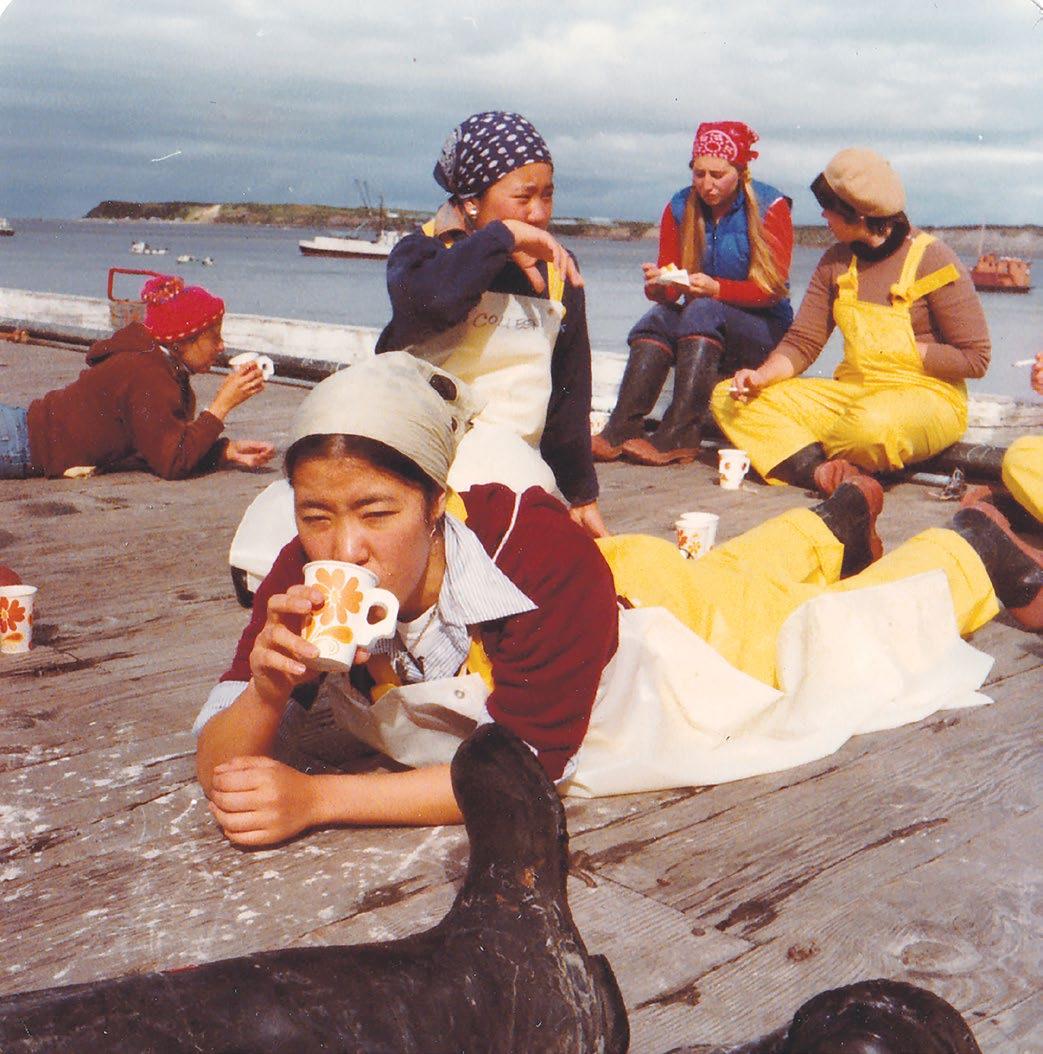
A cannery worker, Yumi, takes a break from the monotony of the slime line or patching table during a 15-minute “mug up” (coffee break) on the dock at the Diamond NN Cannery at South Naknek, ca. 1975. COURTESY OF MIKE RANN.
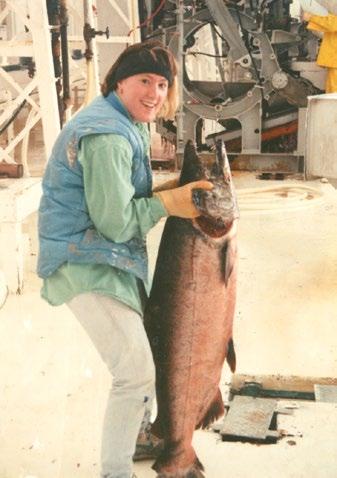
Katherine “Katie” Johnson Ringsmuth holds a large king salmon in the Fish House while she worked as a slimer to earn money for college in 1989. COURTESY OF KATHERINE RINGSMUTH
of more than 50. Due to changes in the market, from canned to fresh frozen, its current owner, Trident Seafoods, shut down the canning operation in 2001. But several of the buildings remained open for storage and as places for fishermen to stay and store their boats. Those buildings and docks, however, weren’t getting any younger. In 2015, Trident shuttered the cannery for good. After 125 years, the closure marked the end of an era.
Ringsmuth and fisheries expert Bob King were in Cordova for the Alaska Historical Society’s annual meeting when they heard the news. They weren’t surprised, King said, but it was sad nonetheless. They knew they had to do something.
For Ringsmuth, preserving the history of such a big player in Alaska’s fishing economy was clearly important, but it was also personal. Originally from a small town in western Washington, she was four years old when she first went to South Naknek, where her father, Gary Johnson, was a cannery bookkeeper who then worked his way up to superintendent, a position he held for 17 years. Growing up, that cannery was her neighborhood.
“Like the salmon, we arrived in the spring and left in late summer,” she said. “We migrated to Bristol Bay. So, when other kids my age were going to Disneyland in the summer, I went to South Naknek.” Childhood memories include playing under the docks, roller skating around the rec hall’s wooden floors, and sneaking donuts from under the noses of the mess hall crew.
“It was kind of a big playground for me.” As a teenager, she worked. She worked in the mess hall, the egg house, and the fish house, among other jobs, to earn money for college. She knows what it means to stand at a slime line for 18 hours until she was so exhausted dead fish started talking smack to her. She knows the work that few outside the industry do, or have given much thought.
“No one knows about the processors,” she said. “They’ve been completely overlooked in history—because sliming is not sexy.
“Most people when they think of fish canneries, think of yucky menial labor… I mean, that’s it, that’s where it stops. Why would I want to know anything beyond that?”
This project intends to answer that question. In November 2016, Ringsmuth, King, Sharon Thompson, and Anjuli Grantham met with Trident officials to seek their blessing, got it, and the NN Cannery History Project was born. It’s actu
ally several projects at once, but has four major components:
• The nomination of the NN Cannery as a maritime district to the National Register of Historic Places.
• The launching of a Project Jukebox oral history archive in collaboration with the University of Alaska Fairbanks and the National Park Service. • A digital storytelling project for Naknek youth that so far has produced 17 short films on everything from women’s roles in the industry to tales of resident ghosts.
• The creation of an exhibit titled Mug Up, as cannery coffee breaks are called, to debut at the Alaska State Museum in Juneau sometime in 2022. The exhibit will take visitors on a tour of an Alaska cannery through stories, films, sounds, objects, and images, with a scale-model of the NN compound by Alutiiq artist Andrew Abyo as the centerpiece.
Included in the exhibit will be the short film, Cannery Caretakers, which is coming together with the help of a $10,000 Alaska Humanities Forum grant. Produced by Jensen Hall Creatives, the film will feature local residents who looked after the cannery in winter and prepared it for work crews in the spring. Most of these caretakers are descendants of the Suqpiat/Alutiiq people who fled Savonoski in 1912 after the Novarupta volcano destroyed their village and created the Valley of Ten Thousand Smokes, burying some areas in what’s now Katmai National Park & Preserve in up to 700 feet of ash.
In addition to educational and historic preservation goals, Ringsmuth hopes the project will bring dignity to this workforce and an appreciation for the skills and expertise it took to do these jobs. The students’ digital storytelling project, for instance, not only encourages Naknek youth to become caretakers of their history, but to “appreciate a mother who canned fish as much as a father who caught fish.”
DEATH COMES TO BRISTOL BAY
Like all canneries of that era, the NN Cannery has its share of unpleasant chapters in its closet, including the days of segregated bunkhouses, mess halls and crews, sexism, and other discriminatory practices. Those injustices were fixable. But the arrival of the Spanish flu pandemic in Bristol Bay in the spring of 1919 was a tragic game changer that altered the human landscape of the region.
Tim Troll presented this piece of the cannery story through a small exhibit he curated called, Bristol Bay Remembers: The Great Flu of 1919, which went up this summer at the Bristol Bay Historical Society Museum in Naknek. The exhibit will be included in the NN Cannery History Project’s Mug Up show.
bottom: Diamond NN Cannery waterfront buildings, July 2019. COURTESY OF KATHERINE RINGSMUTH
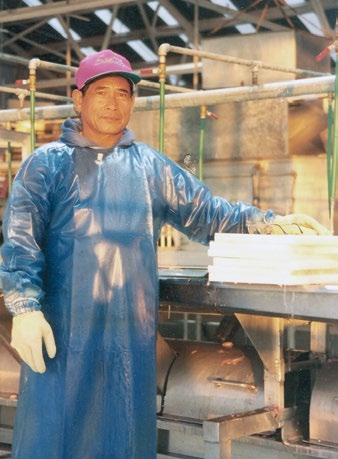
An unidentified Filipino cannery worker poses for a photo after a long day of sliming fish, 1989. COURTESY OF KATHERINE RINGSMUTH.
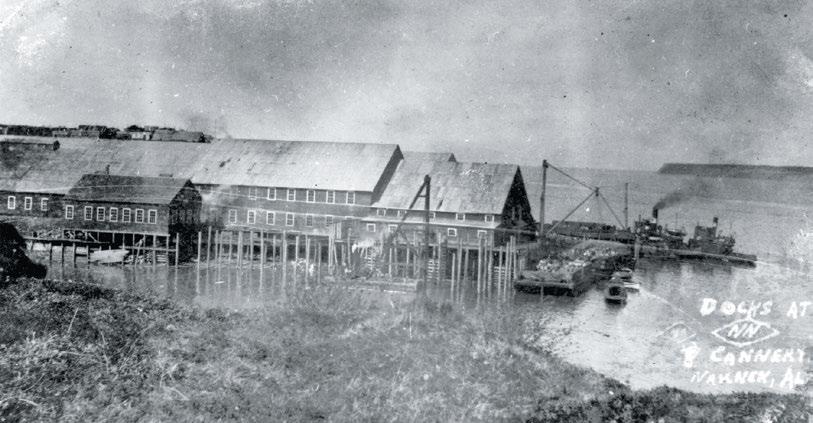
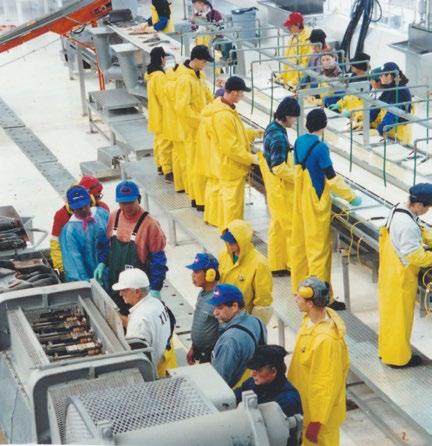
The Fish House crew, consisting of machinists, egg pullers, indexers, and slimers, maintained unique and collaborative skills for the job of cleaning salmon at South Naknek cannery in 1989. COURTESY OF KATHERINE RINGSMUTH

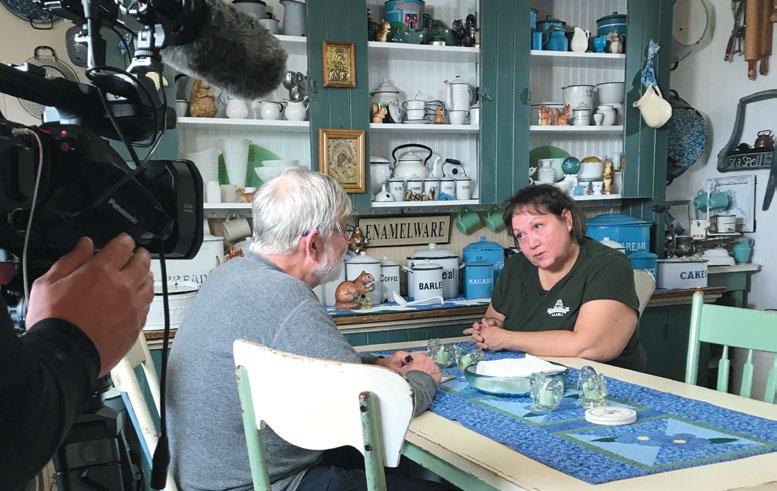
Former KDLG news director Bob King interviews Shirley Zimin in her kitchen at the Winterman’s House at South Naknek. The interview will be part of a short documentary, Cannery Caretakers, that will tell the story of the local community’s relationship to the cannery and the important work they provided for over 100 years. July 2019. COURTESY
OF KATHERINE RINGSMUTH
He got involved with the flu story rather by accident, he said. A number of years ago, a fisherman dropped off an antique wooden box, once used for surgical instruments, at the Dillingham city office. Knowing Troll’s interest in history, the city manager gave him a call.
“So, we opened it up,” said Troll, director of the Bristol Bay Heritage Land Trust, who lived in Dillingham at the time. “There were beautiful little artifacts in for there for the museum and a note that basically said, ‘This box contains items that were given to our grandfather in gratitude for the medical services he provided.... We would like to return them as a gift from our family to the people of Dillingham. Our grandfather was a doctor there.’”
The note was signed by Charles Black. Dr. Linus Hiram French was founder of the Kanakanak Hospital in Dillingham. Most people in Dillingham had never heard of him. Worldwide, the flu pandemic killed people by the millions, and once it hit Bristol Bay, French was at the center of it.
“Fortunately, Black left a phone number. I called him and said, ‘Hey, this is really cool. Did your grandfather take pictures or have any journals or anything?’
“And he said, ‘Oh ya.’ That led to finding well over 500 images and correspondences, and to piecing the story of Dr French and the flu together.”
Troll and John Branson, former long-time historian for Lake Clark National Park, flew to Seattle to meet with French’s descendants at the Burke Museum of Natural History and Culture, which had a large collection of the doctor’s items.
“Ultimately, we got the images from the family and some transcriptions of letters he’d written. So, we were looking at these photos, and after a while we’d see these photos of kids, and, ‘What’s the story there? What’s happening? Oh, wait a minute; these are kids who were survivors of the flu.’”
This particular flu strain tended to kill adults more than children, those with developed immune systems rather than those without, due to a backfiring that caused a deadly overreaction. Among the many heartbreaking accounts, Native children in the region were found alone in settlements, crying and huddled around their dead parents.
French’s documents led Troll to other sources. He learned that the Dillingham doctor and his two nurses were not only overwhelmed caring day and night for others, but were sick themselves. Three of the Alaska Packers Association canneries, including the NN Cannery, had their own hospitals. Best they could, they took care of the sick, built coffins, buried the dead, and looked after the grief-stricken orphans. Eventually, the children were taken to Dillingham, where French laid the groundwork for an orphanage before leaving the territory.
This ties into the NN Cannery story because of how well the Alaska Packers Association canneries responded to the disaster, Troll said. If it hadn’t been for their willingness to drop everything and step up, no doubt more would have died.
Although this year marks the 100th anniversary of the pandemic’s sweep through Bristol Bay, the story hasn’t received much attention.
“I can’t image
Two New Savonoski children, orphaned by the influenza epidemic that hit Bristol Bay in 1919, arrive at the Diamond NN Cannery where they received medical care from the Alaska Packers Association’s doctor and nurse.
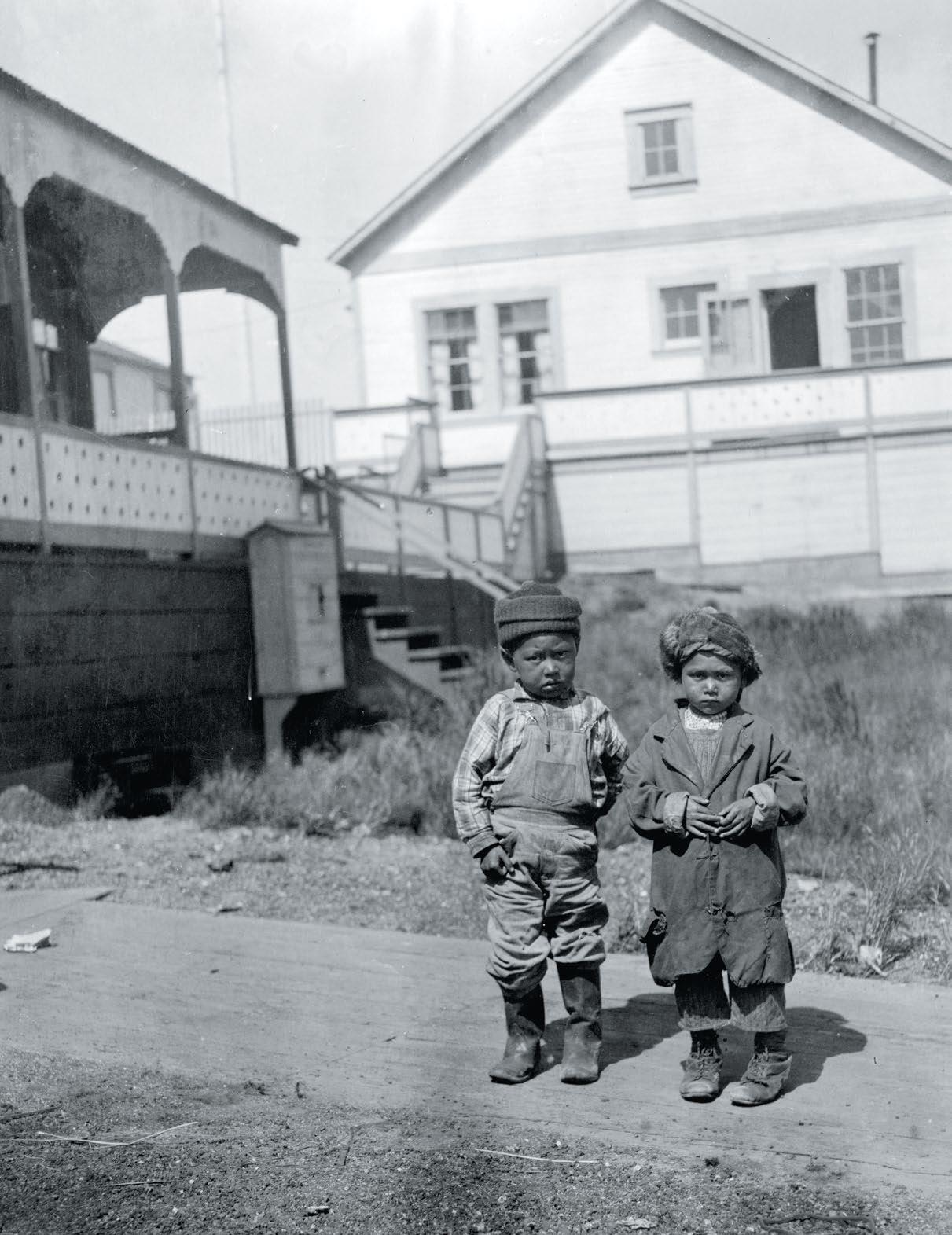
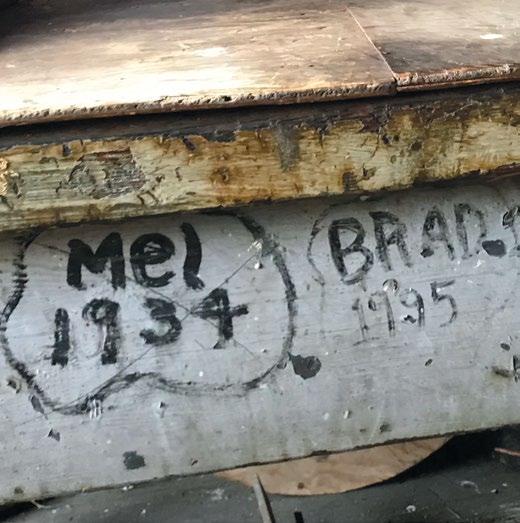

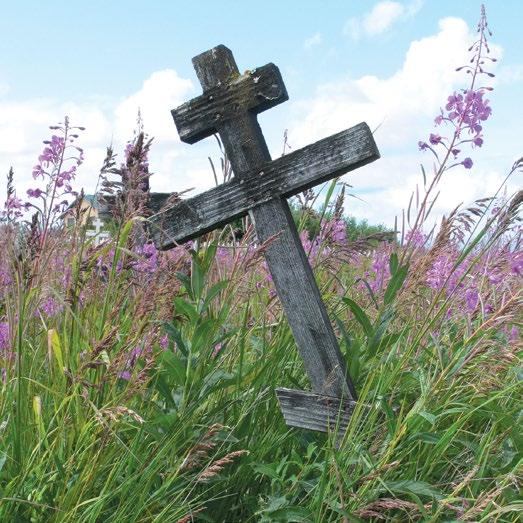
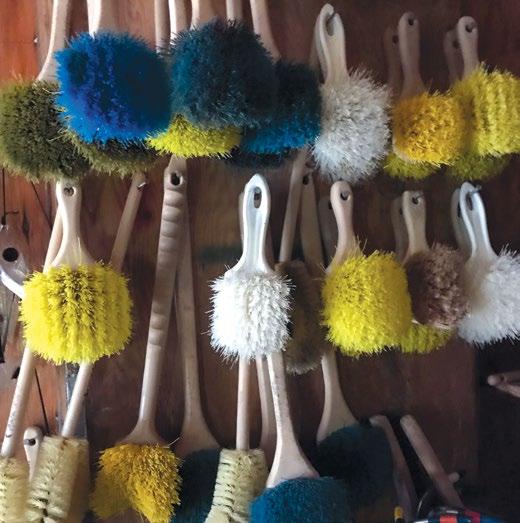
top left: A cross in Orthodox graveyard at he Village of South Naknek, which was settled next to the Diamond NN Cannery. Buried on one side of the graveyard are Orthodox residents, while buried in the other half are fishermen and cannery people of numerous ethnicities and faiths. Since many of the crosses are weathered, the identities and dates of death on many grave sites remain unknown. July 2019. COURTESY OF BOB KING. top right: A Croatian flag carved on top of a table located in the Fisherman’s Bunkhouse at the Diamond NN Cannery. The flag reflects the presence of Croatian immigrants who made of a portion of the independent fishing fleet that caught salmon for the cannery for the cannery at South Naknek. August, 2017. COURTESY OF KATHERINE RINGSMUTH. bottom left: Beach gang workers left behind their names and dates in the rope locker at the Diamond NN Cannery. Graffiti, which can be found on bunkhouse walls, beams, and workspaces through the property, are reminders of the thousands of people from near and far, who, for over the decades, constituted the cannery crew. July 2016. COURTESY OF KATHERINE RINGSMUTH. bottom right: Brushes, once used by the cannery’s clean up crew, hang on a wall in a store room adjacent to the Cannery Building. The room, which hadn’t been opened since the cannery ceased canning salmon in 2001, serves as a kind of time capsule, preserving a glimpse into the underrepresented story of cannery work. July 2019.
COURTESY OF KATHERINE RINGSMUTH.
“It’s not something you celebrate,” Troll said. “But it shaped the region, and the people.
“You read some of the original accounts from the Alaska Packers Association and others who were there, and the descriptions are horrific. Some villages just disappeared. With much of the adult population having been decimated, you had this core of young people who grew up to create the next generation. I can’t image too many families in Bristol Bay that don’t have a connection to an orphan.
“It’s a story people should know.”
HARD TIMES, HARD WORK
Ringsmuth, King, and other members of the project team were in South Naknek in late July to work on the Cannery Caretakers film, interviewing descendants of those who fled Novarupta in 1912, and, seven years later, survived the flu. At one point, King said, they poked around the graveyard at the village’s Russian Orthodox Church searching for graves of flu victims.
“We found some, we think, but it’s hard to tell,” he said.
That graveyard is one of at least three associated with the cannery. Some wooden crosses have fallen over and others are well on their way. If they once had names and dates, they’re gone, faded by time. Some graves have no markers at all.
The old graveyards, including one area that shows up on maps, King noted, as the “China burying ground,” speak to the harsh realities of early cannery life. Ringsmuth has plenty to say about those times. But her personal experiences are what give this project a heartbeat.
She knows what it’s like to leap from bed as late as possible, yank on jeans and a sweatshirt, pull on rubber boots, sprint down to the mess hall, shovel pancakes and eggs into her mouth, gulp a cup of coffee, run down to the boardwalk, climb into her rubberized bibs and slicker, tuck her hair under a hairnet, pull on gloves up to her elbows and, with earplugs jammed in her ears, dash to her position on the slime line just as the whistle blows at 8.
During the peak of the season, at each high tide, tenders would deliver 100,000 to 300,000 pounds of salmon, and the crews would often work until midnight, with breaks for mug ups and meals. Ringsmuth knows what it’s like to work until she can no longer feel her feet, to be so exhausted that demon fish hijack her dreams. Then, the next morning, staggering out of bed and doing it all over again.
“Katie definitely brings the unique perspective of having lived at the cannery, being brought up at the cannery, working in the cannery,” King said. “She knows the people from different cultures… and has great friends among them. It’s
really that perspective that makes the NN Cannery Project special.”
“Where in the universe,” she wonders, “would this small-town, white girl have the opportunity to have that kind of engagement? One where work, rather than race, class, or gender, drove the conversation? I didn’t have to go to New York, I didn’t have to go to London or anywhere in the world because the world was right there.
“Nothing shaped my perspective within the context of work more than that cannery. It cultivated a worldview I didn’t even know I had until much later in life.”
The cannery even factored into her decision to become a historian—coupled with a horrific accident her dad had while vacationing in Florida in 1995.
“He and a friend rented a jet ski, were just tooling around in the jet-ski area, and an 18-year-old kid in a speed boat just mowed them over.”
Her father suffered severe head injuries, and flatlined on the way to the hospital. But he pulled through, and with the help of Trident Seafoods, was eventually medevacked to Harborview Medical Center in Seattle, where he spent months in rehab.
There, fishermen and others from the industry came to visit and told her story after story about his years running the cannery.
“People compared him to a mayor of a town, but in many ways, he was like a baseball coach, or a coach of a team, because he really relied on the expertise of people in all their positions. They really were competitive, and they wanted to beat the other canneries, they wanted to be the best. “His doctors told us it was really important for him to be around his family, that he needed to feel like he had something to get better for. And it was his family, that cannery, and the people who worked for him, and with him, who helped him recover.”
At the time, Ringsmuth’s plan was to become an international journalist, and she’d just received a scholarship to study in Germany. Instead, because of the stories cannery people shared, she changed her major to history.
“Bristol Bay salmon and the cannery gave me everything. It put me through school, became the source of my professional interest; it defined who I am today. And importantly, the cannery and stories of the people who worked there gave me back my dad.”
The NN Cannery Project is her way of giving back. ■
Debra McKinney is a Pulitzer-winning Alaska journalist who writes frequently for FORUM. You can learn more about the project at nncanneryproject.com.

